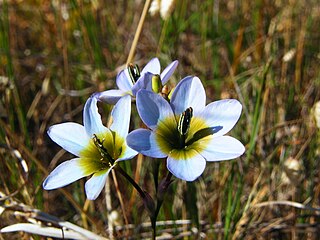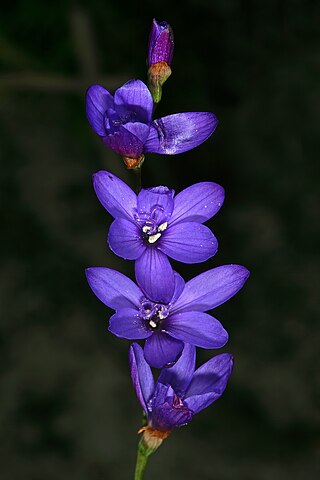
Baeometra is a genus in the family Colchicaceae containing a single species, Baeometra uniflora. It is native to South Africa, where it is commonly called beetle lily due to the dark markings on the tepals.

Ixia monadelpha, also known as the pied kalossie or bontkalossie, is an endangered species of geophyte found in wet sandy flats in the southwestern Cape of South Africa.

Geissorhiza aspera, also known as the blue satin flower or blou sysie, is a geophyte from South Africa.

Acrodon is a genus of ice plants from South Africa. It comprises five species, mostly endangered and all restricted to the southern Cape regions of the Western Cape and Eastern Cape Provinces, South Africa.

Zyrphelis decumbens is a species of perennial plant from the Bainskloof Mountains in the Cape Provinces of South Africa.
Diosma haelkraalensis, or Hagelkraal's diosma, is a rare species of plant endemic to the southwestern Cape Provinces of South Africa.

Cyphia bulbosa, also known by its common name Bulb Baroe, is a species of flowering plant from the genus Cyphia.
Ursinia punctata is a species of plant belonging to the daisy family. It is found growing in South Africa, where it has a wide distribution.
Senecio ruwenzoriensis is an African species of plant. While it is widely distributed, it seems to be highly localised in this range.

Senecio malacitanus, also known as Senecio linifolius is a species of plant from South Africa.
Acrodon deminutus, also known as the Malgas tiptoothfig, is a species of mesemb from South Africa.
Acrodon caespitosus, the Potberg tiptoothfig, is a species of mesemb from South Africa.
Acrodon parvifolius, the Botriver tiptoothfig, is a species of mesemb from South Africa. This species, which grows close to the ground, can best be recognised by its small, thin leaves and its flowers, which form a dome in the middle.
Acrodon subulatus, the Overberg tiptoothfig, is a species of mesemb from South Africa.
Cheiridopsis schlechteri is a species of plant from South Africa. It is a succulent plant that grows in dry habitats.
Cheiridopsis purpurea is a species of succulent plant from South Africa. It is found growing in the succulent Karoo vegetation type.
Cheiridopsis velox is a species of succulent plant from South Africa.
Senecio verbascifolius, the mullein ragwort, is a species of plant from South Africa.
Senecio sophioides is a species of plant from South Africa.
Nemesia glaucescens is a species of plant endemic to South Africa. It belongs to the figwort family.







